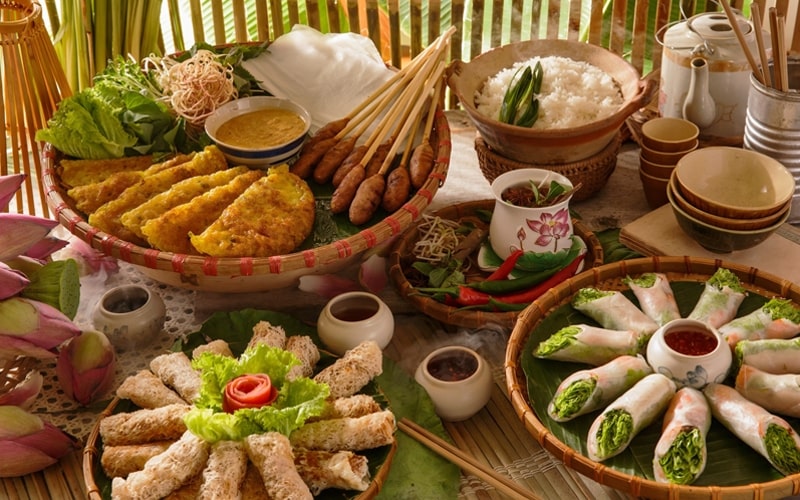Dishes like Hue-style grilled pork rolls, “banh hoi” (thin rice vermicelli sheets), fermented pork rolls, and more are beloved by food enthusiasts for their diverse local ingredients and robust, somewhat spicy flavors.
Situated between the Truong Son mountain range and the East Sea, the geographical diversity and climate of the Central region provide a rich array of culinary ingredients. Among them, chili is considered the soul of the local cuisine. In the preparation of dishes, from breakfast specialties to various dipping sauces, the characteristic flavors are sour, spicy, and salty.
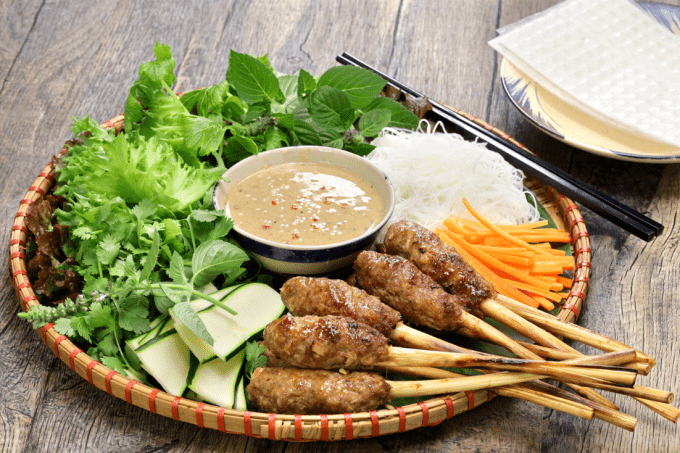
The grilled Hue spring rolls are a specialty of the ancient capital, enchanting the diners and capturing their hearts.
In the North of the Hai Van Pass, the cuisine of the North Central region tends to be spicier and more flavorful than that of the North. The colors of the dishes are diverse, vibrant, leaning towards shades of red and dark red. Accordingly, Thanh Hoa’s cuisine represents a fusion of Northern and Central styles, diverse in dishes, rich in preparation techniques, quality, and beautiful presentation.
Prominent specialties here include fermented pork rolls, “banh gai” (thorny leaf cake), rice porridge with pork, rice cakes with sauce, shrimp paste, Dam Set carp, fish sauce made from anchovies, shrimp paste, and tangy dipping sauces. Tourists often enjoy Thanh Hoa’s fermented pork rolls made with lean meat, pork skin, minced pepper, chili, garlic, and “dinh lang” leaves. When eaten, diners can experience the sweet and pungent taste of fermented meat, the spicy kick of pepper, chili, and a hint of freshness from “dinh lang” leaves.
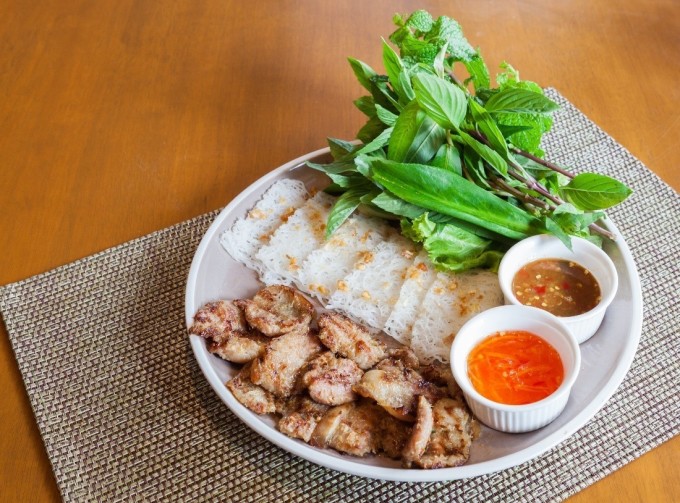
“Bánh hỏi” is made from fragrant rice.
Heading to Nghe An, the local cuisine is humble, robust, and notably unique in its use of unusual spices. Many local specialties are born from this land, such as “nhut” (fermented bamboo shoots) from Thanh Chuong, Nam Dan soy sauce, “banh muot” (soft cake), “banh ngao” (clam cake), and eel dishes like eel soup, eel porridge, eel salad, eel stew with banana and beans, eel stir-fried with lemongrass and chili.
In most dishes, the eel used is fresh, delicious, and firm. After thorough cleaning, it is deodorized with vinegar, seasoned with various spices. When cooked, the eel meat is tender, firm, blending with the sweet and savory taste of the broth and the fragrance of turmeric, pepper, chili, and thin slices of green onion, creating a delightful experience for diners. For eel vermicelli salad, diners can mix a sauce from soy sauce, oyster sauce, and Maggi seasoning cubes to enhance the flavor while preserving the Vietnamese taste.
Hue stands out as a distinctive highlight in the journey of exploring Central Vietnamese cuisine. Here, cuisine is a cultural aspect characterized by elegance and lightness, typical of the former imperial capital, divided into two types: royal and folk. Regardless of the type, Hue dishes are intricately prepared, visually appealing, nutritious, and harmoniously flavored. Notable dishes include “nem cong” (royal rolls), phoenix-shaped sausage, deer tendon, bird’s nest soup, mussel rice, beef vermicelli, Hue sweet soup, “banh chung” (square sticky rice cake), sesame seed cake, and various renowned desserts.
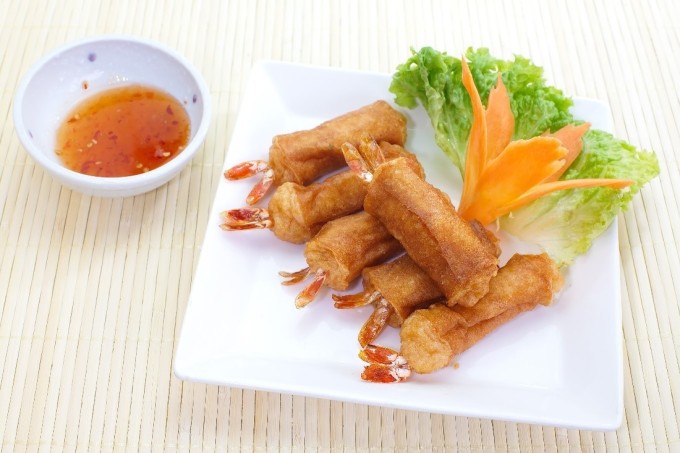
Bình Định shrimp paste is beloved by many diners.
In the South Central region, visitors are impressed by the many dishes with strong flavors of the sea, such as ocean tuna with lotus seed stew, tuna salad, Nam O Da Nang fish salad, bird’s nest soup with lotus seeds, shark skin, shark fin, jellyfish porridge, jellyfish salad, Quy Nhon fish paste, Chau Truc’s barracuda fish with banana and beans stew.
Particularly, tourists should not miss the “banh it la gai” – a traditional cake of Binh Dinh people. The cake harmoniously combines the sweetness of sugar, the richness of mung beans, the fatty taste of coconut, the slight spiciness of ginger, blended with the fragrance of sticky rice, and the thorny leaf.
Ninh Thuan and Binh Thuan are the main residence of the Cham people, with a distinctive culinary culture characteristic of the southern Central region. Here, the dish “chao trang” reflects the pure, simple essence of the spiritual life of the locals. The Cham people often use this dish for breakfast, expressing their wish for a peaceful and tranquil life.
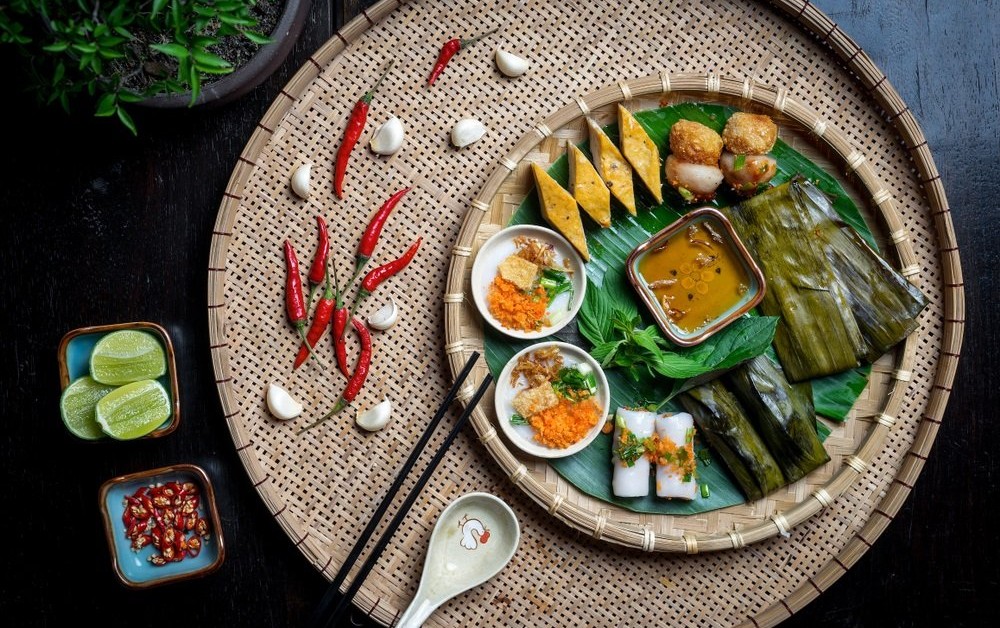
Central Vietnamese cuisine – the essence of Vietnamese culinary art
The Cham people’s cuisine is refreshing, with sour and spicy flavors depending on the weather, climate, rainy or dry season. The distinctive dishes of the Cham people include sour fish soup, “boi” soup (a soup made from various forest vegetables), various fish sauces, goat meat, “rau mon” soup, shrimp spring rolls, and more. Additionally, the Cham people have many types of cakes, mainly serving in religious ceremonies, weddings, and becoming attractive specialties for tourists, such as “banh tet” (cylindrical sticky rice cake), “banh it” (small sticky rice cake), “banh cu gung” (ginger cake), and “banh duc” (steamed cake).
With a patient and diligent character, coupled with skillful hands, the people of the Central region transform local ingredients into famous specialties, attracting visitors from all directions.
